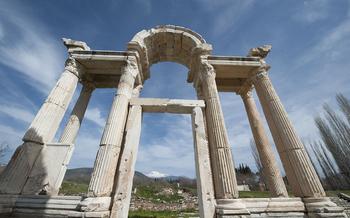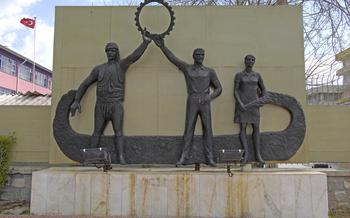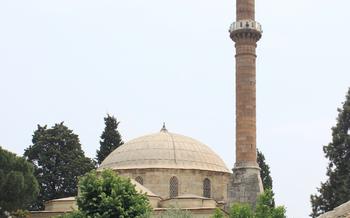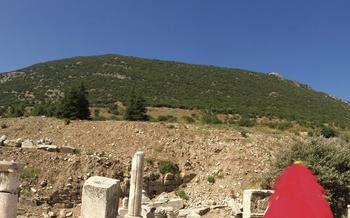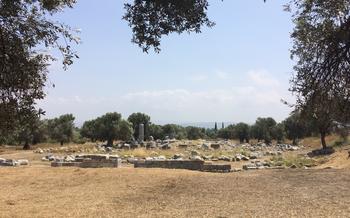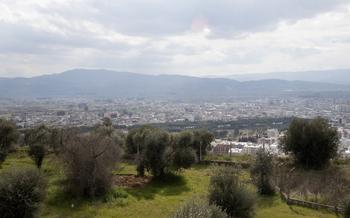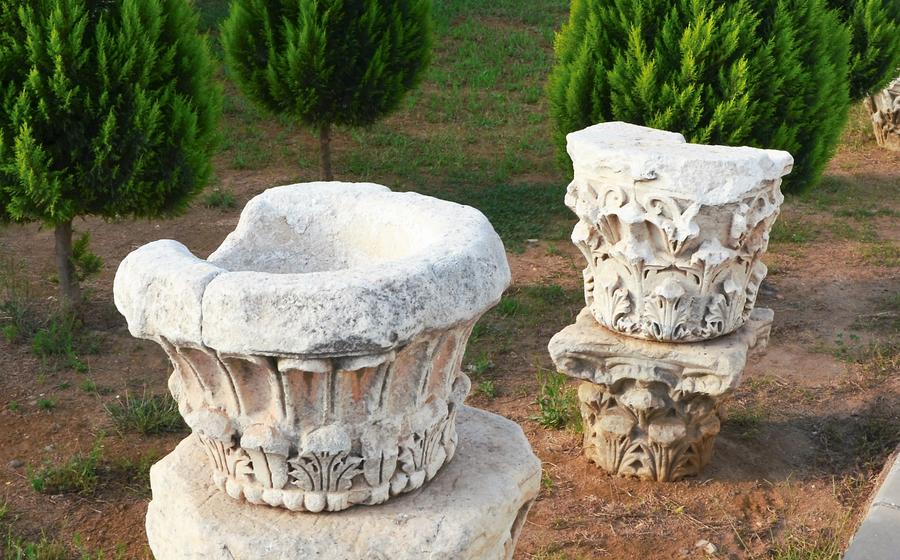
Aydın Archaeological Museum
- Historical Background
- Museum Highlights
- Ancient Statues and Sculptures:
- Mosaics and Frescoes: Exquisite Artworks from Ancient Aydın
- Jewelry and Adornments: Embellishing Ancient Lives
- Ceramics and Pottery
- Coins and Currency
- Religious Artifacts
- Interactive Exhibits
- Educational Programs
- Museum Shop
- Accessibility and Facilities
- Hours of Operation and Admission Fees
- Insider Tip:
Historical Background
Aydın, a city steeped in history, boasts a rich cultural heritage that dates back to ancient times. The establishment of the Aydın Archaeological Museum serves as a testament to the region's profound historical significance. This esteemed institution houses a treasure trove of artifacts that unveils the captivating story of Aydın's past.
The ancient city of Tralles, once a prominent metropolis in the region, played a pivotal role in shaping Aydın's historical narrative. During the Hellenistic period, Tralles flourished as a center of commerce and culture, leaving an indelible mark on the region's legacy. The establishment of the Aydın Archaeological Museum in 1959 marked a significant milestone in preserving and showcasing the remarkable artifacts unearthed from this ancient city and its surroundings.
Museum Highlights
The Aydın Archaeological Museum boasts an impressive collection of artifacts that narrate the rich history of the region. From prehistoric tools to intricate Byzantine mosaics, the museum's exhibits offer a glimpse into the diverse cultures and civilizations that have flourished in Aydın.
Among the must-see exhibits is the "Aydın Man", a 8,000-year-old human skull that provides valuable insights into the earliest inhabitants of the region. The museum also houses a remarkable collection of Lydian coins, which showcase the kingdom's economic prowess and cultural influences.
The "Statue of Artemis", discovered in the ancient city of Ephesus, is a testament to the region's artistic achievements. This majestic marble sculpture portrays the goddess in all her glory, adorned with elaborate jewelry and surrounded by mythical creatures.
Visitors are also drawn to the museum's collection of Byzantine mosaics, which depict religious scenes and imperial portraits with exquisite detail and vibrant colors. These mosaics offer a glimpse into the region's Christian heritage and the artistic traditions of the Byzantine Empire.
With its diverse and captivating exhibits, the Aydın Archaeological Museum offers a journey through time, showcasing the cultural heritage and artistic achievements of one of Turkey's most historically significant regions.
Ancient Statues and Sculptures:
The Aydın Archaeological Museum houses an impressive collection of ancient statues and sculptures that showcase the exquisite craftsmanship and artistry of the region's past. These masterpieces, carved from marble, bronze, and terracotta, offer a glimpse into the lives, beliefs, and cultural practices of the ancient inhabitants of Aydın.
One of the highlights of the collection is a majestic statue of the goddess Artemis, the patron deity of Aydın. Standing tall and graceful, the statue exudes an aura of power and divinity. The intricate details of her clothing, jewelry, and facial features reflect the skill and attention to detail of the ancient sculptors.
Another must-see exhibit is a series of funerary sculptures that depict scenes from everyday life. These sculptures, often found in tombs and burial chambers, provide a fascinating glimpse into the beliefs and customs surrounding death and the afterlife in ancient Aydın.
The museum also boasts a collection of impressive Roman portrait sculptures. These lifelike busts and statues offer a glimpse into the faces of ordinary citizens, wealthy patrons, and emperors who once inhabited the region. The realistic details and expressions captured in these sculptures bring the past to life, allowing visitors to connect with the individuals who lived centuries ago.
The historical and cultural significance of these statues and sculptures cannot be overstated. They serve as tangible links to the past, providing valuable insights into the artistic traditions, religious beliefs, and social structures of ancient Aydın. Whether you're a history buff, an art enthusiast, or simply curious about the region's rich cultural heritage, these remarkable works of art are not to be missed.
Mosaics and Frescoes: Exquisite Artworks from Ancient Aydın
The walls of the Aydın Archaeological Museum come alive with the vibrant colors and intricate designs of ancient mosaics and frescoes. These stunning artworks provide a glimpse into the artistic and cultural achievements of the region's past.
Mosaic Masterpieces:
The museum houses an impressive collection of mosaics, ranging from small, delicate pieces to large, elaborate compositions. These mosaics depict a variety of subjects, including mythological scenes, geometric patterns, and everyday life. The craftsmanship is exquisite, with tiny tesserae (pieces of colored glass, stone, or ceramic) carefully arranged to create lifelike images.
One of the most remarkable mosaics is the "Triumph of Dionysus," which portrays the Greek god of wine riding a chariot drawn by panthers. The mosaic is notable for its vibrant colors and dynamic composition, capturing the essence of the Dionysian cult.
Frescoes: A Glimpse into Ancient Murals
The museum also showcases a collection of frescoes, which are paintings applied directly to the walls or ceilings of buildings. These frescoes have survived remarkably well, offering a glimpse into the decorative techniques and artistic styles of ancient Aydın.
The most notable frescoes depict scenes from mythology and daily life. One fresco, for example, shows a group of musicians playing instruments, while another depicts a hunting scene with dogs and horses. The frescoes provide a glimpse into the social and cultural customs of the ancient world.
Techniques and Symbolism
The mosaics and frescoes in the Aydın Archaeological Museum were created using various techniques. Mosaics were typically made by arranging tesserae onto a prepared surface, while frescoes were painted onto wet plaster. The artists used a variety of colors and pigments to create their vivid and expressive compositions.
The mosaics and frescoes also carry symbolic meanings. Many of the mythological scenes depict stories that were used to teach moral lessons or to commemorate important events. The frescoes, on the other hand, often served a decorative purpose, adding beauty and grandeur to the buildings they adorned.
Overall, the mosaics and frescoes in the Aydın Archaeological Museum are a testament to the artistic and cultural achievements of ancient Aydın. These stunning artworks offer a glimpse into the region's rich history and provide an immersive experience for visitors to the museum.
Jewelry and Adornments: Embellishing Ancient Lives
The Aydın Archaeological Museum houses a captivating collection of jewelry and adornments that once embellished the lives of ancient Aydın's inhabitants. These exquisite pieces offer a glimpse into the artistry, craftsmanship, and cultural significance of ancient times.
From delicate necklaces and intricate earrings to elaborate bracelets and rings, the jewelry on display showcases the remarkable skills of ancient jewelers. The intricate designs and meticulous attention to detail are a testament to the high level of craftsmanship that existed in ancient Aydın.
Beyond their aesthetic appeal, these adornments held deep cultural and symbolic meaning. Necklaces often incorporated amulets and talismans believed to protect the wearer from harm or bring good fortune. Earrings and bracelets served as symbols of status and wealth, while rings were often used to seal important documents or mark special occasions.
The jewelry in the Aydın Archaeological Museum provides a glimpse into the personal adornment practices of ancient Aydın. These exquisite pieces not only adorned the bodies of their wearers but also reflected their cultural beliefs, social status, and personal style.
Ceramics and Pottery
The Aydın Archaeological Museum houses a diverse collection of ceramics and pottery that provides valuable insights into the daily life and trade practices of ancient Aydın. These artifacts showcase the region's rich ceramic tradition and technological advancements.
The museum displays a variety of ceramic vessels, including amphorae, jugs, bowls, plates, and cooking pots. These vessels were used for various purposes, such as storing food and liquids, serving meals, and cooking. The intricate designs and decorations on these ceramics often depict scenes from mythology, daily life, or religious rituals, offering a glimpse into the artistic and cultural expression of the ancient inhabitants.
One of the highlights of the collection is a collection of finely crafted terracotta figurines. These figurines represent various deities, mythological creatures, and human figures, providing valuable insights into the religious beliefs and practices of the ancient Aydın people. The figurines are often adorned with intricate details and vibrant colors, showcasing the exceptional artistry and craftsmanship of the ancient ceramicists.
The museum also houses a collection of imported ceramics from various regions of the Mediterranean, including Greece, Italy, and North Africa. These imported ceramics demonstrate the extensive trade networks that existed in ancient Aydın and the region's cultural interactions with other civilizations.
By studying the ceramics and pottery on display, visitors to the Aydın Archaeological Museum can gain a deeper understanding of the daily life, trade practices, and artistic achievements of this ancient city. These artifacts provide a tangible connection to the past, offering a glimpse into the rich cultural heritage of Aydın.
Coins and Currency
In the Aydın Archaeological Museum, a remarkable collection of ancient coins and currency offers a glimpse into the economic and political systems of the region. These coins, minted from various metals such as gold, silver, and bronze, bear intricate designs and inscriptions that provide valuable insights into the history of Aydın.
Among the highlights of the collection are the electrum coins, a blend of gold and silver, that were issued by the Lydian Kingdom in the 7th century BC. These coins, considered to be the world's first bimetallic coinage, showcase the advanced monetary system of the Lydians.
The museum also displays a diverse range of coins from different periods and civilizations that ruled Aydın. From the impressive silver tetradrachms of the Hellenistic period to the intricate gold dinars of the Islamic era, each coin tells a story of trade, power, and cultural exchange.
The collection of coins and currency not only serves as a testament to the economic prowess of ancient Aydın but also sheds light on the political and social dynamics of the region. Visitors can trace the evolution of monetary systems, gain insights into the economic relationships between different cultures, and appreciate the artistry and symbolism embedded in these ancient coins.
Religious Artifacts
The Aydın Archaeological Museum houses a remarkable collection of religious artifacts that provide a glimpse into the spiritual beliefs and practices of ancient Aydın. Among the most notable exhibits are statues of various deities, such as Zeus, Apollo, and Aphrodite, intricately carved from marble or bronze. These statues showcase the exceptional craftsmanship of ancient artisans and offer insights into the religious iconography of the region.
In addition to statues, the museum displays a diverse array of amulets and votive offerings. Amulets were believed to protect the wearer from harm or bring good luck, while votive offerings were dedicated to deities in exchange for favors or blessings. These artifacts provide valuable insights into the personal religious practices and beliefs of the ancient Aydın people.
Interactive Exhibits
The Aydın Archaeological Museum takes visitor engagement to the next level with its interactive exhibits, designed to make history come alive and create a memorable learning experience. Through hands-on displays, multimedia presentations, and immersive technologies, visitors can explore the past in a dynamic and engaging way.
One of the highlights is a virtual reality tour that transports visitors back in time to ancient Aydın. Using VR headsets, they can wander through the streets, visit ancient landmarks, and interact with historical figures, gaining a first-hand perspective of life in a bygone era.
Another interactive exhibit features a 3D model of the ancient city, allowing visitors to explore its layout, buildings, and monuments from different angles. They can zoom in to examine intricate details and learn about the city's architecture and urban planning.
For a more hands-on experience, visitors can participate in pottery-making workshops, where they can learn the techniques used by ancient artisans to create beautiful ceramic vessels. They can also try their hand at coin minting, using replicas of ancient dies to create their own coins.
These interactive exhibits not only enhance the visitor experience but also cater to different learning styles, making the museum accessible and enjoyable for people of all ages and backgrounds.
Educational Programs
The Aydın Archaeological Museum goes above and beyond by providing a range of educational programs and workshops aimed at promoting cultural awareness and learning. These programs are meticulously designed to engage and inspire visitors of all ages, fostering a deeper appreciation for the region's rich history and heritage.
The museum offers guided tours tailored to specific interests, allowing visitors to delve into the captivating stories behind the artifacts and gain insights from knowledgeable guides. These tours provide an immersive and interactive experience, transforming the museum's galleries into a living testament to the past.
Moreover, the museum hosts workshops that provide hands-on experiences for participants to engage with the ancient world. From pottery classes that replicate traditional techniques to educational sessions that unravel the mysteries of ancient scripts, these workshops offer a unique opportunity to connect with the past in a tangible way.
These educational initiatives not only enhance the visitor experience but also contribute to the museum's mission of preserving and promoting the region's cultural heritage. By fostering a sense of connection and understanding, the Aydın Archaeological Museum plays a vital role in ensuring that the legacy of the past continues to inspire and educate generations to come.
Museum Shop
The Aydın Archaeological Museum features a well-stocked museum shop that offers a wide range of souvenirs and replicas for visitors to purchase. From intricate replicas of ancient artifacts to contemporary interpretations of historical designs, the shop provides a unique opportunity to take home a piece of Aydın's rich cultural heritage.
Visitors can browse through a variety of items, including replicas of ancient jewelry, pottery, and sculptures. These high-quality replicas are crafted with meticulous attention to detail, ensuring that they are both aesthetically pleasing and historically accurate.
The museum shop also offers a selection of books and publications related to Aydın's history, archaeology, and culture. These publications provide in-depth insights into the region's past and present, making them valuable resources for scholars, history buffs, and anyone interested in learning more about Aydın.
Proceeds from the museum shop directly support the museum's mission of preserving and promoting Aydın's cultural heritage. By purchasing souvenirs and replicas, visitors can contribute to the ongoing conservation and educational efforts of the museum, ensuring that future generations can continue to appreciate and learn from the region's rich history.
Accessibility and Facilities
The Aydın Archaeological Museum is committed to providing an accessible and welcoming environment for all visitors. The museum is wheelchair accessible, with ramps and elevators throughout the building. Visitors with disabilities can also borrow wheelchairs from the museum's front desk.
The museum offers a variety of facilities to enhance the visitor experience. There are restrooms located on every floor of the museum, as well as a café where visitors can purchase snacks and drinks. A cloakroom is also available where visitors can store their belongings while they explore the museum.
The museum staff is always happy to assist visitors with any questions or requests. Visitors can ask for directions, information about the exhibits, or assistance with using the museum's facilities.
Hours of Operation and Admission Fees
The Aydın Archaeological Museum is open to the public from Tuesday to Sunday, except for Mondays and national holidays. The museum's hours of operation are typically from 8:30 am to 5:00 pm. It is advisable to plan your visit accordingly to avoid any inconvenience.
Admission fees are quite reasonable, ensuring that history and culture are accessible to all. Full admission tickets are priced at a modest rate, while discounted tickets are available for students, senior citizens, and groups. Additionally, free admission is offered to children under the age of eight, making it an excellent opportunity for families to explore the museum's treasures together.
Insider Tip:
For an unforgettable experience, plan your visit to coincide with one of the museum's special events or guided tours. These events offer a unique opportunity to delve deeper into the history and significance of the artifacts on display. Check the museum's website or social media pages for upcoming events and guided tour schedules. Additionally, consider joining a local tour group or hiring a knowledgeable guide who can provide insights and anecdotes that bring the museum's collection to life.



